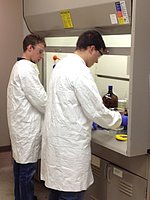COA's Microplastic Research: Overview

(above) Student volunteer collecting a water sample.
Microplastics, or plastic pieces < 5 mm in size, are increasingly common in the marine environment and cause serious ecological concerns. In the process of degradation, plastic debris releases toxic chemicals used in their production, such as bisphenol A (BPA) and styrene trimer (a liquid hydrocarbon), which have been linked to endocrine disruption. Plastics in the ocean have also been known to attract persistent, bio-accumulating and toxic substances (PBTs),[1] which include polychlorinated biphenyls (PCBs), dioxins, and petroleum based chemicals. There are two sources of microplastics: 1) the breakdown of larger pieces and 2) manufactured products.[2] To document the scope and magnitude of microplastics on New Jersey shorelines, in waterways, and marine life, Clean Ocean Action (COA) assembled a research team of national and international scientists in January 2014 to establish a model for assessing marine microplastics using citizen science principles.
With design protocols developed in collaboration with this research team, COA launched the first microplastics research study in New Jersey in order to establish a model for similar marine and coastal environments. Initial sampling was conducted in the spring of 2014 and engaged specially trained high school students (photo below) and citizen volunteers. The first phase involved nearly 200 samples (of sand and water) that were collected along the coast of New Jersey and processed and analyzed at the micron level at the National Oceanic and Atmospheric Administration (NOAA) James J. Howard Marine Sciences Laboratory at Sandy Hook in consultation with NOAA scientists. The protocols and techniques have been successful in extracting and identifying microplastics in both media.

In tandem with this first phase of research, COA created a Citizen Manual, modeling the Environmental Protection Agency’s (EPA) Estuaries Monitoring Manual.[3] This Citizen Manual was produced to guide and standardize citizen participation in the microplastics investigation.
With its interdisciplinary Research Team and guided by the principles of citizen science, COA will be implementing two additional phases of microplastics investigation. These include assessing plastics visible to the naked eye along with the presence and abundance in the intestinal tract of common marine fishes which will include engaging recreational and commercial fishermen. At each phase of the project, the Citizen Manual will be amended to include such phase to create a model for future endeavors.
Each phase of the research will be linked to the identification of sources and solutions to prevent the release and reduction of microplastics in the marine environment. COA is engaging with citizens and policy makers to accomplish this through education and advocacy, specifically through EPA Region II's Trash Free Waters Program.
The U.S. Environmental Protection Agency (EPA) developed the Trash Free Waters (TFW) Program in 2014 as a means to identify a focused set of actions that support trash prevention and reduction initiatives by many public and private stakeholders. Stakeholders decided to focus TFW initiatives to combat the plastic plague. The group is tackling the issue in the following categories: boxes, microplastics, cigarette butts, bottles, and bags. Along with other projects, the microplastics working group is highlighting research being done in Region 2 with a goal of data standardization.
To learn more about COA's microplastics research, specifically, the multiple phases, download the Microplastics Research Agenda. To learn more about other microplastics research happening in this region, download an overview here.
For more information about microplastics and how to get involved, contact Catie Tobin, Principal Investigator.
[1] Mato, Y., Isobe, T., Takada, H., Kanehiro, H., Ohtake, C., & Kaminuma, T. (2001). Plastic resin pellets as a transport medium for toxic chemicals in the marine environment. Environmental Science and Technology, 35, 318-324.
[2] Hidalgo-Ruz, V., Gutow, L., Thompson, R., Thiel, M. (2012). Microplastics in the Marine Environment: A Review of the Methods Used for Identification and Quantification. Environmental Science and Technology, 46, 3060-3075.
[3] Ohrel, R., Register, K. (2006). Volunteer Estuary Monitoring: A Methods Manual, Second Edition. Found at water.epa.gov/type/oceb/nep/upload/2007_04_09_estuaries_monitoruments_manual.pdf

